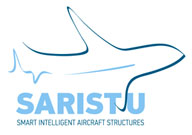| Posted: Jun 19, 2014 | |
Smart design and nanotechnology to cut aircraft operational costs |
|
| (Nanowerk News) Continuous innovation in aircraft design has led to fuel savings, noise reductions and lower fares for passengers by making flights more efficient. Now an EU-funded project aims to take Europe's aircraft industry to the next level by combining smart new design techniques to further cut development time and costs. | |
 The EU-funded SARISTU (Smart Intelligent Aircraft Structures) project, which was launched in September 2011, has focused on the potential application of new materials at specific design phases. By integrating different materials for the wing for example, the consortium has demonstrated that they can achieve a 6 % reduction in drag, meaning that less fuel is needed to complete a flight. New aerodynamic designs are also lighter and generate less noise. This will help reduce the impact of overhead aircraft on neighbourhoods near airports. While such improvements might appear to be merely small-scale adjustments in one aspect of aircraft design, they could have major implications. Some 2.2 billion people a year take to the skies for business or pleasure, which means that pollution and noise from air travel present the industry with a significant challenge. This is why airlines, aircraft manufacturers and researchers are constantly on the lookout for new ways to make their planes lighter, more aerodynamic and achieve greater fuel efficiency, and why the SARITSU project is of such potential importance. A specific goal of the SARITSU project, which is due for completion in August 2015 and has received just over EUR 32 million in EU funding, is to combine various technologies in order to achieve manoeuvrable wingtips. So far, the SARISTU consortium has developed a tab using new materials and technology that can actually change shape during flight. This enables pilots to keep air resistance as low as possible. |
|
| Other innovations have been incorporated to ensure that this development functions properly. After all, a gap between the flap and the fixed aircraft wing would cancel out any positive effect, which is why the team has developed an elastic connecting element. This element is essentially a resin containing carbon nanotubes - nanoscale structures that possess immense strength - which retains its elasticity at incredibly cold temperatures. The resin has also been manufactured to cope with high wind speeds. | |
| Another significant advantage of using carbon nanotubes in these new resins is the potential for weight reduction. Weight savings of up to 3 % are possible when compared to traditional fixed systems. And by combining a range of other new technologies, the cost of electrical network installations in planes could be reduced by 15%. | |
| All in all, SARISTU represents a major step forward in successfully integrating smart intelligent structural concepts into traditional aircraft design, and reflects the potential of nanotechnology in aircraft manufacturing applications. Furthermore, the project has shown that incremental improvements taken together can lead to significant weight and operational cost reductions and lead to improved aerodynamic performance. |
| Source: Cordis |
